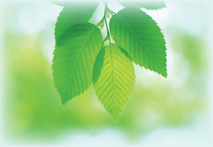8 Study Guide
 Cellular Basis of Life
Cellular Basis of Life
Photosynthesis is the process by which organisms convert light energy into chemical energy that all organisms can use directly, or indirectly, to carry out life functions.
8.1 Energy and Life
 ATP can easily release and store energy by breaking and re-forming the bonds between its phosphate groups. This characteristic of ATP makes it exceptionally useful as a basic energy source for all cells.
ATP can easily release and store energy by breaking and re-forming the bonds between its phosphate groups. This characteristic of ATP makes it exceptionally useful as a basic energy source for all cells.
 In the process of photosynthesis, plants convert the energy of sunlight into chemical energy stored in the bonds of carbohydrates.
In the process of photosynthesis, plants convert the energy of sunlight into chemical energy stored in the bonds of carbohydrates.
8.2 Photosynthesis: An Overview
 Photosynthetic organisms capture energy from sunlight with pigments.
Photosynthetic organisms capture energy from sunlight with pigments.
 An electron carrier is a compound that can accept a pair of high-energy electrons and transfer them, along with most of their energy, to another molecule.
An electron carrier is a compound that can accept a pair of high-energy electrons and transfer them, along with most of their energy, to another molecule.
 Photosynthesis uses the energy of sunlight to convert water and carbon dioxide (reactants) into high-energy sugars and oxygen (products).
Photosynthesis uses the energy of sunlight to convert water and carbon dioxide (reactants) into high-energy sugars and oxygen (products).
pigment (230)
chlorophyll (230)
thylakoid (231)
stroma (231)
NADP+ (232)
light-dependent reactions (233)
light-independent reactions (233)


8.3 The Process of Photosynthesis
 The light-dependent reactions use energy from sunlight to produce oxygen and convert ADP and NADP+ into the energy carriers ATP and NADPH.
The light-dependent reactions use energy from sunlight to produce oxygen and convert ADP and NADP+ into the energy carriers ATP and NADPH.
 During the light-independent reactions, ATP and NADPH from the light-dependent reactions are used to produce high-energy sugars.
During the light-independent reactions, ATP and NADPH from the light-dependent reactions are used to produce high-energy sugars.
 Among the most important factors that affect photosynthesis are temperature, light intensity, and the availability of water.
Among the most important factors that affect photosynthesis are temperature, light intensity, and the availability of water.

Think Visually Using the information in this chapter, complete the following flowchart about photosynthesis.
Table of Contents
- Formulas and Equations
- Applying Formulas and Equations
- Mean, Median, and Mode
- Estimation
- Using Measurements in Calculations
- Effects of Measurement Errors
- Accuracy
- Precision
- Comparing Accuracy and Precision
- Significant Figures
- Calculating With Significant Figures
- Scientific Notation
- Calculating With Scientific Notation
- Dimensional Analysis
- Applying Dimensional Analysis





